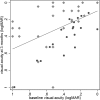Italian real-life experience on the use of ocriplasmin
- PMID: 30123843
- PMCID: PMC6093221
- DOI: 10.1136/bmjophth-2017-000110
Italian real-life experience on the use of ocriplasmin
Abstract
Objective: To evaluate the success of an intravitreal injection of ocriplasmin to release symptomatic vitreomacular traction (VMT) and close a full-thickness macular hole.
Methods and analysis: An observational retrospective multicentre study conducted in Italy. Patients with symptomatic distortion and loss of vision secondary to VMT were included in the study. The patients received a single injection of ocriplasmin and were followed up for 1, 3 and 6 months. Best-corrected visual acuity (BCVA) and spectral domani OCT (SD-OCT) were performed for patient assessment, and adverse events were recorded and analysed.
Results: 74 patients (74 eyes) were included in the study. 44 of 74 eyes (59.5%) experienced complete release of the VMT. Macular hole closure was obtained in eight eyes (40%). BCVA improved about three lines after 3 months of follow-up in the patients with VMT resolution in comparison with the patients who did not have VMT resolution (p<0.0001). In 55/74 eyes of 55 patients (74.3%), no adverse events were reported, and most of them were transitory (17/19; 89.5%). The mean time to resolve VMT was 27.4±21.9 days. No cases of retinal tear, retinal detachment or lens destabilisation were observed.
Conclusion: Ocriplasmin is a potential alternative treatment for patients with symptomatic VMT and has a good safety profile. A more careful selection of patients, in clinical practice, may increase the success rate.
Keywords: retina; treatment medical; treatment other; treatment surgery; visual perception; vitreous.
Conflict of interest statement
Competing interests: None declared.
Figures




References
LinkOut - more resources
Full Text Sources
Other Literature Sources
